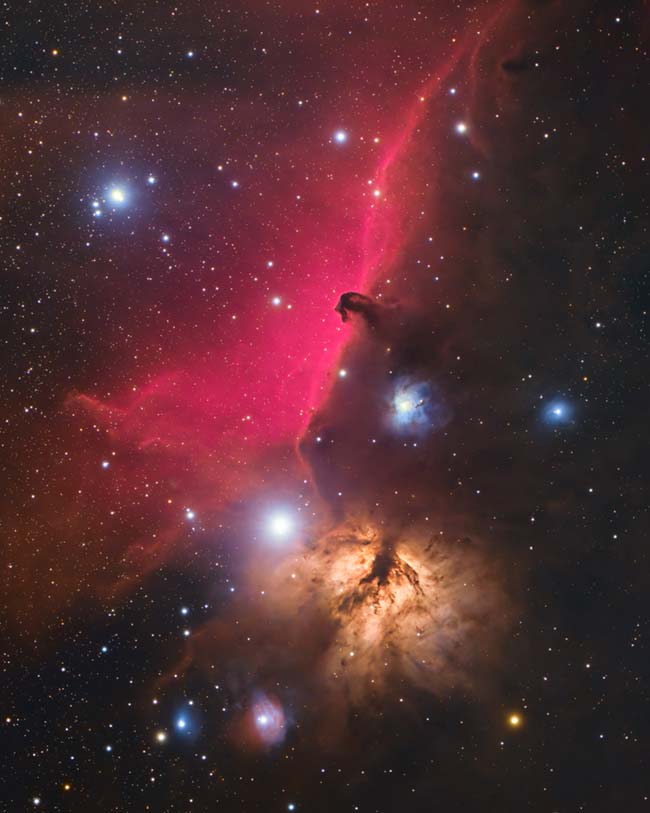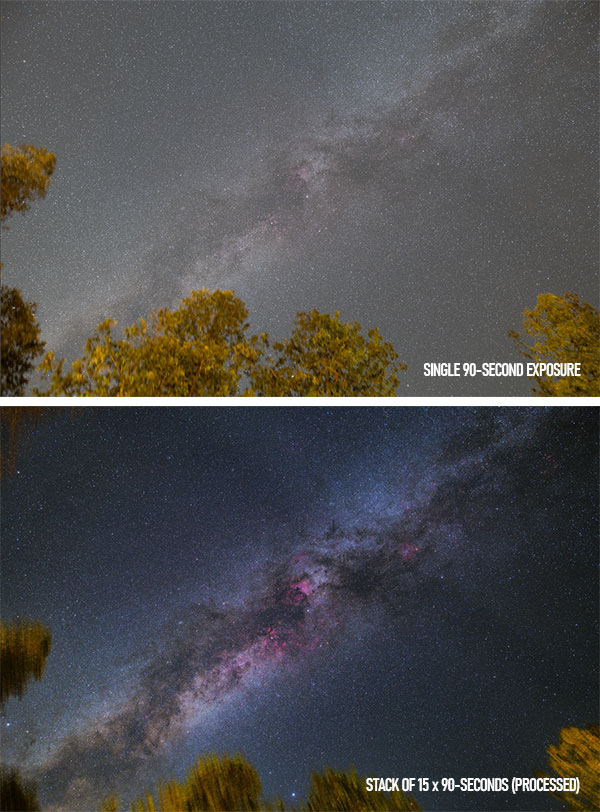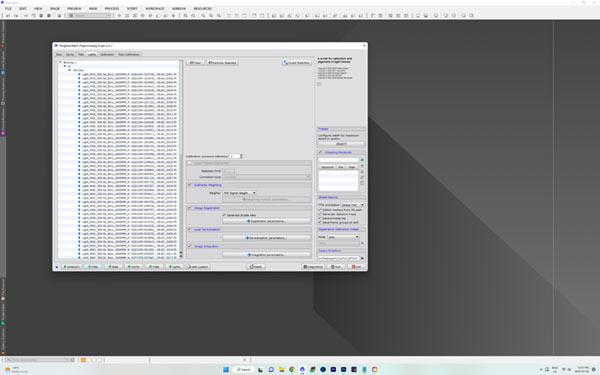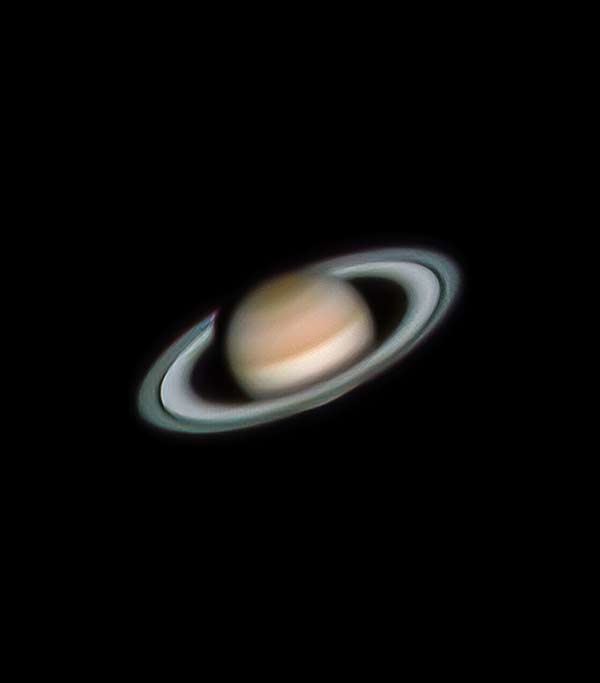Image Stacking Software
Choosing an astrophotography image stacking software that compliments your editing workflow and produces reliable results is one of the first hurdles every amateur astrophotographer is faced with. There are many great options available, and they all generally do the same thing in different ways.
The process of image stacking combines several photos of the same object to improve the overall signal-to-noise ratio and lower noise in the final image. This is something I do for each and every one of my astro-images, whether it is a wide-field nightscape, or a high-resolution deep-sky object.
Some of the most popular image stacking software choices are DeepSkyStacker, PixInsight, and Siril. If you are looking for the absolute highest level of control, PixInsight is likely the best choice, but it is also the most advanced. You may be able to achieve similar results using one of the free stacking software options on this list.
The process of image stacking is normally accomplished by aligning and averaging the image frames, which enhances the overall image quality and helps to bring out, subtle, important details. By combining several shorter-exposure images, the technique can also be used to make images with an ultra-long total integrated exposure time.
Example: 60 x 3-minute exposures = 3 hours of total overall exposure time.
Image stacking is one of the most important aspects of astrophotography image processing, and learning how to master this process will allow your images to reach their full potential. The process may seem confusing at first, so I have created a premium image processing guide (that includes detailed stacking instructions) for beginners.
If you are interested in learning more about specific astrophotography image processing techniques, be sure to check out the astrophotography tutorials section of this website. You can also view my extensive list of astrophotography resources, which includes tools for acquisition, planning, and even weather forecasting.
Related Article: Choosing an Image Processing Software
Astrophotography Image Stacking Software
There are several tools and methods available for astrophotography image stacking, from manually aligning and stacking the image frames in Photoshop to sophisticated stacking and calibration software tools like DeepSkyStacker and Siril.
The bottom line is the more images you stack, the better. Eventually, you will reach a point of diminishing returns, but I rarely achieve this feat myself due to a lack of clear sky time in my backyard. For me, a typical deep-sky image project will include anywhere from 4-10 hours of total exposure time.
In this article, I will focus on the best software for astrophotography image stacking, based on your unique goals and desired user experience.
This image includes nearly 10 hours of total integrated exposure time through image stacking.
How do you Stack Images in Astrophotography?
There are several methods for stacking images in astrophotography, but one commonly used method is called “median stacking.” This is the method I typically use, and it involves collecting a sequence of individual image exposures on my desired target first (using the same camera settings).
If you have ever taken a single 30-second image exposure at night with your DSLR camera using ISO 800-ISO 1600. You will notice that there is a noticeable amount of noise present in the image. An image stacking software can help remove the noise and increase the amount of overall light (or signal) collected.
Whether I am using a simple DSLR camera and lens on a star tracker, or a dedicated astronomy camera and a large telescope, I always capture multiple image exposures of each target. These sequences can be anywhere from 20 – 200 frames. In the image below you can see how much more detail I was able to bring out on a wide-angle photo of the night sky.
A stack of 15 images will have a much better signal-to-noise ratio than a single image exposure.
Because the signal (the light emitted by stars and deep-sky objects) is constant, it will compound as you collect more and more overall exposure time. The noise, however, is random. The stacking software will essentially cancel these unwanted artifacts out.
The basic process is as follows:
- Align the images using software such as DeepSkyStacker. This step ensures that the individual image frames are properly aligned before stacking.
- After the image frames are aligned, stack the images using a ‘median’ stacking method. In this method, the software will take the median value of each pixel from all the images at that location and use that value to create the final image.
- Once the stacking process is complete, the final image will be a composite of all the images used in the stack, with much of the noise and other unwanted artifacts reduced.
- To calibrate the images and remove unwanted artifacts such as dust motes and vignetting, flat frames must be incorporated into the stacking process.
- Finally, you can post-process the stacked image with editing software like Adobe Photoshop or PixInsight to boost saturation and perform other adjustments to get the final desired result.
Please note that this is a very basic example of image stacking, and does not include the advanced calibration side of things. By subtracting dark frames and bias frames, you can further improve the overall quality of the master image.
There are several great software tools available for image stacking, and the good news is, many of them are free. Let’s take a look at a few of them.
Best Image Stacking Software for Astrophotography
The following list of software tools has been vetted by myself or others I know who have successfully processed many deep-sky images. I have intentionally not numbered the stacking tools on this list to highlight the fact that the best image-stacking software is the one you feel most comfortable using, and more importantly, understand.
Remember that image stacking is part of the pre-processing stages. This will create an intermediate file that you can then bring into a tool like Photoshop or PixInsight to edit to your heart’s delight.
Adobe Photoshop
Website: https://www.adobe.com/ca/products/photoshop.html
One of the most simple ways to begin image stacking is to do it manually in Adobe Photoshop. Utilizing layers, place and align each one of your image frames on top of one another and gradually reduce the opacity.
This is a great way to see the power of signal-to-noise ratio at work, as you can watch your master image file gradually improve as you add each new layer. Even though Photoshop technically can auto-align the layers for you, it often results in an error because the tool really wasn’t meant to be used for astrophotography.
Adobe Photoshop is best used for simpler astrophotography projects, such as a series of 6-12 images of the Milky Way or a starry nightscape image. The graphic below shows a typical method of image stacking in Photoshop by manually placing and aligning layers of the same image on top of one another.
Manual Image Stacking in Adobe Photoshop.
Since Photoshop wasn’t designed to stack astrophotography images, there is no way to incorporate important calibration frames such as dark, bias, or flat frames into your project. For some tools that are up to this task, read on.
DeepSkyStacker
Website: http://deepskystacker.free.fr/english/index.html
DeepSkyStacker is my overall favorite image-stacking tool for astrophotography.
DeepSkyStacker is a popular software used for image stacking and post-processing in astrophotography. It has a user-friendly interface, which makes it easy for beginners to learn and use. The software can automatically align and stack multiple images, which helps to reduce noise and bring out faint details in the final image.
The software has various noise reduction options like automatic hot pixel removal, dark frame subtraction, and flat-field correction. DeepSkyStacker is compatible with a wide range of image formats, including RAW, TIFF, and FITS, which makes it easy to work with different types of images.
DeepSkyStacker is freeware, which means it’s free to download and use. There is a large community of users who share their experiences and tips on how to use the software, which can be helpful for beginners. The software does a great job of stacking deep-sky images of galaxies and nebulae, and even comets.
Keep in mind that DeepSkyStacker is available for Windows only, so to use it on a Mac you will need to use an alternate version (not tested) or use Bootcamp utility to run Windows on your Mac.
Siril
Website: https://siril.org/
Siril is a free image stacking and processing software with advanced features.
Siril is an open-source software for stacking and processing astronomical images. It offers advanced image calibration tools, such as dark frame subtraction, flat field correction, and bias correction to improve the quality of your final integration.
It offers a wide range of image processing tools, such as color balance, contrast, and brightness adjustments. It also has the ability to run scripts, which can automate the image processing and stacking workflow, which can save a lot of time.
Siril is available for Windows, Mac, and Linux, which makes it accessible to most users. It’s open-source software, which means it’s free to download and use. Many amateur astrophotographers use Siril and share their experiences and tips on YouTube, which is very helpful for beginners.
Siril support various image format like FITS, SER, AVI, PNG, TIFF, and more. Siril is especially useful for advanced users who want to automate their workflow.
Sequator
Website: https://sites.google.com/view/sequator/
Sequator is easy to use and my go-to option for Milky Way Photography and Nightscapes.
Sequator is a free, open-source software for stacking and processing astronomical images, it is designed to work with both deep-sky images and wide-field nightscapes. I usually recommend Sequator to those shooting with a DSLR camera and tripod, taking wide-angle photos of the night sky.
Like all of the astrophotography image stacking tools on this list, it can stack multiple image frames together to reduce noise and create a master image for further processing. I like to use Sequator on wide-angle nightscape style shots like constellations and Milky Way photography.
Sequator offers some advanced image calibration tools, without the confusion and daunting task of learning new software. It is likely the most beginner-friendly tool on this list. I have found that it stacks images faster than DeepSkyStacker, even when using calibration frames (darks) on a deep-sky image.
Below, you can watch my video tutorial using Sequator on my astrophotography images:
It has a clever tool for separating (masking) the foreground of your image to only stack the stars in the night sky. This is handy when capturing nightscapes images where the ground is moving independently from the sky. It supports RAW image format files from your DSLR or mirrorless camera, but it is not meant for dedicated astronomy camera files (FIT).
PixInsight
Website: https://pixinsight.com/
The WBPP script automatically finds and stacks each file from a large ‘batch’ of images for a particular project.
PixInsight is a professional-grade image processing software that is widely used in astrophotography for stacking, processing, and analyzing images. It offers advanced alignment and stacking features for astrophotographers who are ready to take on the complexities of such an advanced tool.
Like the other image stacking tools, PixInsight has various noise reduction options like automatic hot pixel removal, dark frame subtraction, and flat-field correction, with more parameters to adjust than you could ever imagine. I stick to the Weighted Bacth Pre-Processing (WBPP) stacking script, as this automates much of the experience and does a great job.
If you plan on using PixInsight for image stacking, you will benefit from the many online tutorials available, such as the ones by Shawn Neilson (Visible Dark Astro). The following video discusses his PixInsight stacking methods for best results.
Overall, PixInsight is a powerful and versatile software with advanced tools for amateur astrophotographers who want to do it all. The software is not cheap, but it is a one-time purchase.
Astro Pixel Processor
I found Astro Pixel Processing to be a powerful and effective software, but the user interface can be confusing at times.
Website: https://www.astropixelprocessor.com/
Astro Pixel Processor, often called ‘APP’ was developed by Mabula Haverkamp. He has developed new innovative features and algorithms to the software such as its unique debayer algorithm Adaptive Airy Disc, Local Normalization Correction, and fully automatic N-View mosaics.
The author of the software has stated that the goal of APP is to ‘make a complete Deep-Sky Image Processing application that maintains ease of use while automatically using the most advanced algorithms to provide excellent results without the need to tweak dozens of parameters.’
I know of several fellow astrophotographers that enjoy and use the mosaic tool in Astro Pixel Processor, a complex task for any image stacking tool. To date, I have only used APP a handful of times, and it provided great results using the default parameters.
Autostakkert!
I use Autostakkert! to process my images of planets by extracting image frames from a video file.
Website: https://www.autostakkert.com/
Autostakkert! is a free planetary astrophotography image stacking software. I use this when photographing planets through my telescope at high magnification. It is rather simple to use, and is suitable for images of the moon, planets, and the sun.
The process of stacking individual image frames from a video file format is quite different from long-exposure deep-sky astrophotography. The key to this process is selecting the best images frames (with the least amount of atmospheric disturbance) to stack and produce the final output.
My go-to source for everything to do with planetary imaging is ‘InsertAstroNameHere’ (Matt Smith) on YouTube. The following video really helped me understand this software when I got started with planetary imaging and Autostakkert!.
It’s worth noting that a typical planetary image processing workflow involves another tool called Registax. This allows you to use wavelet processing to reveal more details on the planet’s surface.
Smart Telescopes
If you want to let a smart telescope handle the image stacking for you, there are several great options available to amateur astrophotographers today. They can automatically take a series of image exposures, align them, and stack them for a better image.
For example, the live stacking feature on the Seestar S50 does a great job of registering the pictures and combining them, considering they were taken on an Alt-Az tracking mount. I found the Dwarf 3 (shown below) also did a great job of image stacking internally.
Smart telescopes like the Dwarf 3 can internally stack images for you (live stacking) to produce a cleaner image.
All of these devices provide the option of stacking your own image frames separately for more control. For those just looking to explore space without learning how to use image stacking software, smart telescopes are a fantastic option.
Summary
Select an image-stacking software that suits your personal comfort level in terms of user experience. For example, for Milky Way Photography, a tool like Sequator is likely all you will need to create a clean image to edit in Adobe Photoshop.
If you are an advanced deep-sky astrophotographer trying to calculate the ideal image scale of your telescope system for maximum resolution, PixInsight has the power and functionality you need. I tend to stick with DeepSkyStacker and the WBPP script in PixInsight for most of my personal astrophotography projects.
No matter which stacking software you choose, you will benefit greatly from the many astrophotography tutorials found on YouTube.












